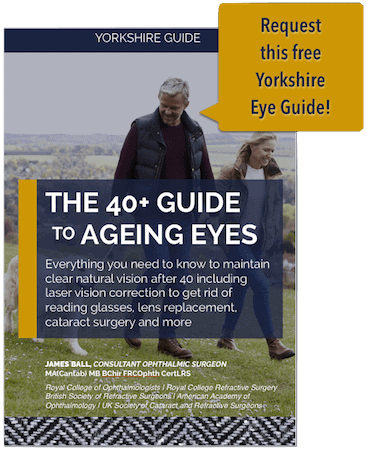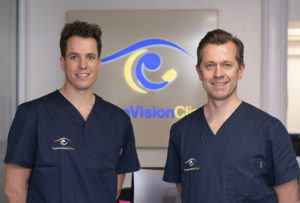What is corneal cross-linking (CR3)?
Cross-linking is a proven, non-invasive treatment for keratoconus, which is a severe form of astigmatism.
Corneal collagen cross-linking with riboflavin is a new treatment that increases the stiffness and rigidity of the cornea and stabilises keratoconus. Patients who previously had progressive keratoconus have now been treated with CCR (3). They have been followed for over five years with 95% showing no progression of their condition.
Dentists have used collagen cross-linking for many years. Prof. Theo Seiler and Prof. Eberhard Spoerl at the University of Dresden first developed cross-linking as a treatment for the cornea in 1993. The first patients were treated in 1998. Today, eye surgeons perform corneal cross-linking in more than 500 centres around the world. In many centres, it is the standard treatment for keratoconus, which reduces the need for a corneal transplant.
Who is suitable for corneal cross-linking (CR3)?
Cross-Linking is a relatively new treatment and its place in the treatment of keratoconus is still being defined. This will become more apparent as more people are treated around the world, and the results of these treatments are published. To date, the published literature suggests that cross-linking is most suitable for patients with progressive keratoconus. That means patients whose glasses or contact lens prescription is changing quite frequently, or whose vision is becoming worse despite using contact lenses, or whose corneal topography maps show a clear progression of keratoconus.
How do we treat keratoconus?
James Ball explains the different treatment options for treating keratoconus, including corneal cross-linking, intrastromal corneal rings and how he'd like to make corneal transplants for keratoconus no longer needed.
How does corneal cross-linking (CR3) work?
The strength and rigidity of the cornea are partly determined by how strongly the fibres are linked together.Cross-linking uses riboflavin and ultraviolet light to chemically bond the front layers of collagen in the cornea together. This makes the cornea 300% stiffer and stops the progression of keratoconus.
Riboflavin (vitamin B2) is a naturally occurring compound which strongly absorbs UV light. By applying riboflavin to the cornea at the same time as exposing it to a UV light source, the riboflavin enhances the cross-linking effect of the UV light.
Hundreds of ophthalmologists perform cross-linking on tens of thousands of keratoconic patients internationally since 1998.
The cross-linking treatment is carried out with topical anaesthesia (eye drops), which numb the surface of the eye. The patient feels no discomfort during the procedure.
The surface epithelial cell layer is removed from the central part of the cornea, and the riboflavin drops applied.
Once the riboflavin has penetrated into the cornea, the UV light is focussed onto the central area of the cornea for 10 minutes.
Finally, a bandage soft contact lens is applied. The contact lens is worn for up to 2 weeks until the surface epithelial cell layer has re-grown. During the first few days, the eye will be sore and watery.
We advise resting with both eyes shut for as much of the time as possible during the first 48 hrs after the operation. This will significantly improve your comfort in the initial period.
Eye drops will be given that are preventive against infection and inflammation. The use of the eye drops will be discussed with you before you leave the clinic.
You can return to work after one week, resume sports activities after approximately two weeks, and swimming and sauna after approximately three weeks.
You may drive a vehicle again only with the doctor's permission, usually after the first week.
After the corneal cross-linking operation
In the first period (1-3 months) after cross-linking, you are much more sensitive to light (glare), and the vision is worse for a short time. Only once the cornea has become stable should you consider glasses or contact lenses for definitive correction of any residual spectacle error. Some people choose to seek temporary glasses or contact lenses during the recovery period. In general, a hard contact lens can be worn again after 1- 2 months.
Advantages and disadvantages of corneal cross-linking (CR3)
Benefits of Cross-Linking
Cross-linking is effective in stabilising the progression of keratoconus in the majority of patients. Studies have shown that for about 95% of Keratoconus patients the cross-linking procedure prevents further vision loss.
In a minority of patients, the treatment gives an additional small measure of benefit in reducing the corneal steepness and irregularity. This, in turn, means some reduction in the short-sightedness and astigmatism associated with keratoconus.
Risks of Cross-Linking
Potential complications of cross-linking are rare. They include corneal haze, corneal infection, corneal inflammation, corneal scarring, and the need for repeat surgery.
Options and alternatives to corneal cross-linking (CR3)
Ophthalmic surgeons can combine cross-linking with intracorneal or intrastromal rings to flatten the keratoconus cone even more. The rings stabilise keratoconus which prevents it from getting worse. The intracorneal or intrastromal rings also reverse the keratoconus steepening that has occurred before the treatment.
Results at a glance
My eyesight following the operation is brilliant and better than I thought possible, and this is all down to your excellent surgeon Mr James Ball and not to forget all the very dedicated people around him who make these operations possible.
Keith Garlick
Two of the best decisions I ever made in my life were firstly to have lens exchange and secondly to have Mr James Ball carry out my operation.
Patricia Walton
Within minutes I could tell there was a difference. But now, only a couple of months later, my sight is better than it was seven years ago! I can even read the really tiny print on the car sales ads! If you want that confidence you probably felt when you were younger, this is the ideal solution. Thanks to the treatment, I feel rejuvenated, independent and much younger!
John Hazelgreave
Many thanks for all your care and kindness. To me it appears a miracle that I can see so well. I feel very grateful. It is impossible to fully express my thanks.
Grace C.
May I offer grateful thanks for your expertise in operating on my eyes. It was intimated to me that you were the best, and from the results I am now enjoying, I am convinced that this is correct.
Jean D.
You are truly innovative. Thank you very much for curing the problems I have been having with my reading and near vision.
Sala M.
My work was becoming almost impossible. I had refractive lens exchange to both eyes with multifocal lens implants last July. I can now see better than 20/20 for distance and can read the tiniest print in newspapers - all without glasses! I have started reading for pleasure again, and I feel that my performance both at work and on the golf course has improved.
John
Request a callback
I felt I was treated as an individual and all my questions were answered. From my experiences – I can highly recommend Custom Vision Clinic.
Our reviews on Trustpilot
Further information about eye conditions
Discover your eye treatment options
Give us a call on: 0345 643 0466
Or request a call back:
More Useful Information




